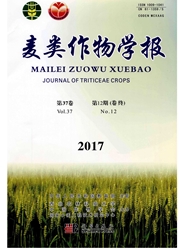

 中文摘要:
中文摘要:
为了解冬小麦刈割后的氮素调控作用,在温室控制条件下,以冬小麦品种陇育2号为材料,在分蘖期刈割后施氮0、0.1、0.2、0.3、0.4 g·kg^-1土(分别用N0、N1、N2、N3、N4表示),探究了冬小麦刈割后干物质积累、氮素吸收和产量对不同施氮水平的响应。结果表明,与N0处理相比,刈割后施氮使小麦拔节期和开花期的叶面积指数提高90%-155%(P〈0.05)。施氮处理延长了小麦生长旺盛期3-6 d,促进了干物质积累,其中N2处理干物质积累量增加129%(P〈0.05),并且提高了穗部干物质的分配比例。施氮提高了开花期茎部可溶性碳水化合物含量,其中N2处理的增幅达到39%(P〈0.05)。冬小麦各器官氮素含量均随施氮量的增加而增加,刈割后施氮使氮素转运效率提高6%左右(P〉0.05),氮素收获指数提高10%-15%(P〈0.05)。施氮处理的籽粒产量、穗粒数、有效穗数和收获指数较N0处理增加显著(P〈0.05),且以N2处理效果最好,说明0.2 g N·kg^-1土是冬小麦刈割后良好生长发育、高产、稳产、氮素高效利用的最佳施氮水平。
 英文摘要:
英文摘要:
In order to investigate the re-growth of clipped winter wheat and the relationship between absorption and nutrition of nitrogen,a local commercial winter wheat cultivar Longyu 2 was used as the basic material with pot experiments in the controlled greenhouse,to investigate the regulation of different nitrogen treatments on DM of wheat,allocation,yield and absorption of nitrogen. Four nitrogen treatments were applied to the clipped winter wheat as 0,0. 1,0. 2,0. 3 and 0. 4 g·kg^-1soil,namely N0,N1,N2,N3 and N4,respectively. The results were as follows: compared to N0,the leaf area index of wheat in the treatment groups were increased by 90% to 155%( P〈0. 05) at the elongation and flowering stages,and vigorous growth duration of winter wheat was prolonged by 3 - 6 days; the accumulation of DM increased significantly,especially increased by 129% at N2( P〈0. 05); the stem water soluble-carbohydrate( WSC) of wheat with nitrogen application was 39%( P〈0. 05) higher than N0 at the flowering stage. N accumulation in different organs increased with the increase of nitrogen application amount. In addition,compared to the control,N translocation rate increased by about 6%,and N harvest index increased by 10% to 15%( P〈0. 05). Grain yield,grain number,productive spikes,and harvest index of winter wheat with nitrogen application were all higher thanthat of the control,and the highest for those traits were at N2( P〈0. 05). Therefore,it indicated that the application of 0. 2 g N·kg^-1soil was an optimum practice to stabilize grain yield of clipped winter wheat.
 同期刊论文项目
同期刊论文项目
 同项目期刊论文
同项目期刊论文
 期刊信息
期刊信息
